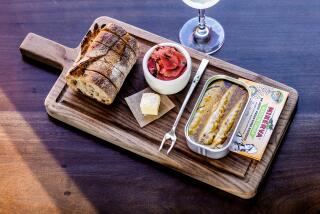Pressure canning can feed your family cheaply and efficiently
- Share via
It’s Week 7 in my canning and preserving course and we reached the place where, as our teacher Ernest Miller says, “the rubber meets the road.” That’s pressure canning, and anyone who had a DIY grandmother or mother (and yes it was the women for the most part) who put up beans or soups or even fish probably saw one of these big old pots with gadgets on top of her stove.
We “canned” chicken and split pea soup. The “canning” refers to the process; we actually put the food into Ball jars. In this case, the process is the key. The food was really easy: just cut up bite-size chunks of raw chicken for one jar, and a simple split pea soup, partially cooked, for the other.
Pressure canners -- which can be used as pressure cookers, but not vice versa -- can seem a little scary. They’re big, and it’s easy to imagine them exploding. But Miller says they’re safe when used properly, and we had no untoward incidents in our class, one of 12 in a canning preserving course offered through Food Forward.
In short, the jars are put into the canner, water not covering them. The lid goes on and then the heat. Wait 10 minutes once the vent on top starts emitting steam, which allows the canner to be full of steam, with no air. Then the pressure gauge is put on the lid; set, in our case, to 10 pounds per square inch.
Our soup and chicken cooked at 240 degrees for 75 minutes; the canner is constructed so a little movement and noise from the gauge lets you know the cooking is proceeding properly. The jars cool in the canner.
Miller said there are two kinds of pressure canners: the weighted gauge that we used, and those with a dial gauge. The disadvantage of the latter is that they need to be recalibrated annually.
Miller uses pressure canning for soups, chilis, sauces, meats, beans, vegetables. “I love jellies and jams, but you can’t feed your family on that,” he said. And all of them can be made to taste. More pork in the pork and beans, more chile in the chili, whatever suits.
It’s an efficient and economical way to preserve food, a method first used in France in the 1600s, and by the early 20th century the U.S. Department of Agriculture had figured out how to make sure the canned food was free of botulism.
Miller told the story of a woman who canned peas without following the proper procedure. She thought she was OK because she’d so far survived. But after she was told she was rolling the dice with her life, she fed all her peas to her chickens. Half of them died.
Before safe mechanisms were set, Miller said, “entire families would be wiped out by opening the wrong can.” What more encouragement do you need to follow the directions for canning properly?
ALSO:
Daniel Patterson book a challenge
Thank Charlie Trotter for microgreens
More to Read
Eat your way across L.A.
Get our weekly Tasting Notes newsletter for reviews, news and more.
You may occasionally receive promotional content from the Los Angeles Times.








